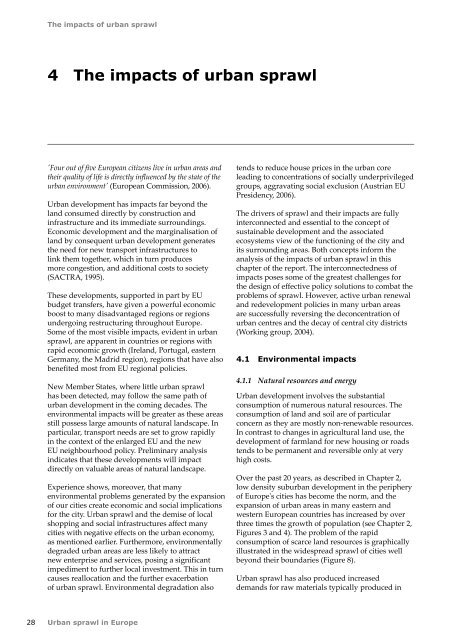Session 1 - Montefiore
Session 1 - Montefiore
Session 1 - Montefiore
Create successful ePaper yourself
Turn your PDF publications into a flip-book with our unique Google optimized e-Paper software.
28<br />
The impacts of urban sprawl<br />
4 The impacts of urban sprawl<br />
'Four out of five European citizens live in urban areas and<br />
their quality of life is directly influenced by the state of the<br />
urban environment' (European Commission, 2006).<br />
Urban development has impacts far beyond the<br />
land consumed directly by construction and<br />
infrastructure and its immediate surroundings.<br />
Economic development and the marginalisation of<br />
land by consequent urban development generates<br />
the need for new transport infrastructures to<br />
link them together, which in turn produces<br />
more congestion, and additional costs to society<br />
(SACTRA, 1995).<br />
These developments, supported in part by EU<br />
budget transfers, have given a powerful economic<br />
boost to many disadvantaged regions or regions<br />
undergoing restructuring throughout Europe.<br />
Some of the most visible impacts, evident in urban<br />
sprawl, are apparent in countries or regions with<br />
rapid economic growth (Ireland, Portugal, eastern<br />
Germany, the Madrid region), regions that have also<br />
benefited most from EU regional policies.<br />
New Member States, where little urban sprawl<br />
has been detected, may follow the same path of<br />
urban development in the coming decades. The<br />
environmental impacts will be greater as these areas<br />
still possess large amounts of natural landscape. In<br />
particular, transport needs are set to grow rapidly<br />
in the context of the enlarged EU and the new<br />
EU neighbourhood policy. Preliminary analysis<br />
indicates that these developments will impact<br />
directly on valuable areas of natural landscape.<br />
Experience shows, moreover, that many<br />
environmental problems generated by the expansion<br />
of our cities create economic and social implications<br />
for the city. Urban sprawl and the demise of local<br />
shopping and social infrastructures affect many<br />
cities with negative effects on the urban economy,<br />
as mentioned earlier. Furthermore, environmentally<br />
degraded urban areas are less likely to attract<br />
new enterprise and services, posing a significant<br />
impediment to further local investment. This in turn<br />
causes reallocation and the further exacerbation<br />
of urban sprawl. Environmental degradation also<br />
Urban sprawl in Europe<br />
tends to reduce house prices in the urban core<br />
leading to concentrations of socially underprivileged<br />
groups, aggravating social exclusion (Austrian EU<br />
Presidency, 2006).<br />
The drivers of sprawl and their impacts are fully<br />
interconnected and essential to the concept of<br />
sustainable development and the associated<br />
ecosystems view of the functioning of the city and<br />
its surrounding areas. Both concepts inform the<br />
analysis of the impacts of urban sprawl in this<br />
chapter of the report. The interconnectedness of<br />
impacts poses some of the greatest challenges for<br />
the design of effective policy solutions to combat the<br />
problems of sprawl. However, active urban renewal<br />
and redevelopment policies in many urban areas<br />
are successfully reversing the deconcentration of<br />
urban centres and the decay of central city districts<br />
(Working group, 2004).<br />
4.1 Environmental impacts<br />
4.1.1 Natural resources and energy<br />
Urban development involves the substantial<br />
consumption of numerous natural resources. The<br />
consumption of land and soil are of particular<br />
concern as they are mostly non-renewable resources.<br />
In contrast to changes in agricultural land use, the<br />
development of farmland for new housing or roads<br />
tends to be permanent and reversible only at very<br />
high costs.<br />
Over the past 20 years, as described in Chapter 2,<br />
low density suburban development in the periphery<br />
of Europe's cities has become the norm, and the<br />
expansion of urban areas in many eastern and<br />
western European countries has increased by over<br />
three times the growth of population (see Chapter 2,<br />
Figures 3 and 4). The problem of the rapid<br />
consumption of scarce land resources is graphically<br />
illustrated in the widespread sprawl of cities well<br />
beyond their boundaries (Figure 8).<br />
Urban sprawl has also produced increased<br />
demands for raw materials typically produced in











